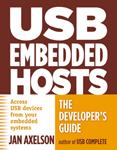Home > USB Embedded Hosts > Table of Contents
 USB Embedded Hosts
USB Embedded Hosts
Contents
Introduction
1 USB Essentials
How Data Travels on the Bus
How the Host Communicates with Devices
2 USB Hosts for Embedded Systems
Embedded Hosts are Different
Necessary Hardware
What the Host Does
Choosing a Development Platform
3 Using Linux in Embedded Systems
Getting Started
Creating and Running Applications
Issues for Embedded Systems
Providing Data for Debugging
4 Exploring USB in Linux
Learning about Attached Devices
Monitoring USB Traffic
5 Accessing Files on Drives
Inside the Mass Storage Class
Detecting a Drive
Reading and Writing to Files
6 Getting User Input
Inside the Human Interface Device Class
Reading Keypresses
7 Bridging to Other Interfaces
Inside the Communications Devices Class
Using a USB Virtual Serial Port
Communicating on a Network
Communicating over Bluetooth
8 Printing
Inside the Printer Class
Printer Control Languages
Printing Files
9 Using Sound and Video
Inside the Audio and Video Classes
Playing and Recording Sound
Playing and Recording Video
10 Communicating with Vendor-defined Devices
Driver Options
Using a Generic Driver
Accessing Vendor-defined HID-class Devices
Using a USB Display Monitor
11 Implementing a Dual-role Port
Inside USB On-The-Go (OTG)
Supporting OTG Functions
Implementing a Peripheral Function
